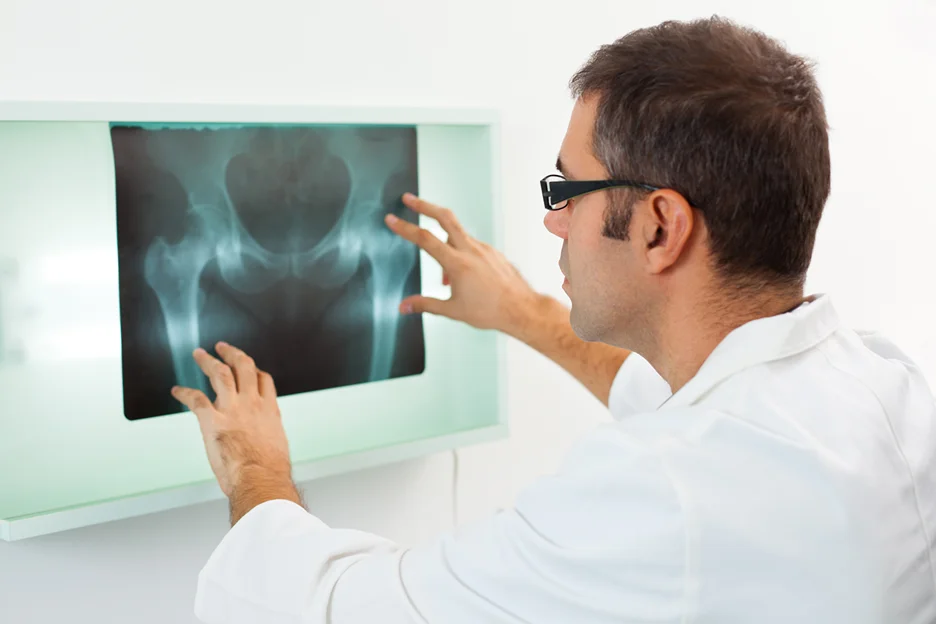How to Know You’re on the Road to Recovery
Sciatica, at its core, refers to the pain stemming from the sciatic nerve, which extends from the lower back through the hips and buttocks, and down each leg. While it’s often caused by an underlying condition like a herniated disc or bone spur, what’s important is recognizing its progression.
The Progression of Sciatica: From Start to Chronic Stages
The Acute Phase
Sciatica often begins with the acute phase. This is when an individual first feels that characteristic pain radiating from the back, through the hip, and into the leg.
Common triggers include prolonged sitting or improperly lifting heavy items. Initially, the discomfort primarily spans from the lower spine, descends to the buttocks, and trails down the back of the leg.
The Transition to Sub-Acute Phase
If not addressed, the acute phase can transition into the sub-acute phase, which may span several weeks to months.
In this phase, individuals might notice the pain intensifying, accompanied by symptoms like numbness, tingling, or even weakness in the leg or knee. It’s an indication that the condition is persisting and possibly worsening.
The Chronic Phase
Should the sub-acute phase remain unmanaged, it might usher in the chronic phase of sciatica. This stage sees persistent and recurring sciatica symptoms.
More than just pain, complications may arise, including a burning sensation in the affected leg and, in extreme cases, cauda equina syndrome—a serious condition where nerve roots get compressed.
Treatment Approaches in Advanced Stages of Sciatica

Conservative Approaches in Advanced Sciatica
Taking a conservative stance initially can pave the way for pain relief and management. Physical therapy stands out as an excellent approach to set the tone for a structured stretching regimen, ultimately refining posture to lessen the burden on the sciatic nerve.
- Physical Therapy: Develop a routine focusing on stretching and exercises. Improves posture and relieves pressure on the sciatic nerve.
- Pain Management: Techniques to control pain levels and reduce the intensity of flare-ups.
- Ergonomic Adjustments: Consider changes like an ergonomic chair, using orthopedic shoe inserts, bending with knees, and avoiding prolonged sitting with items in back pockets.
Medication for Advanced Sciatica
Medications, both over-the-counter and prescription-based, can offer solace from persistent sciatica pain. It’s essential to opt for the right medicines based on the condition’s severity.
- NSAIDs: Over-the-counter drugs like ibuprofen and naproxen not only help manage pain but also reduce inflammation, a common culprit behind sciatic discomfort.
- Prescription Medications: For more severe pain, doctors might prescribe stronger muscle relaxants or anti-inflammatories. These offer a more potent relief, especially during intense flare-ups.
- Others: In some unique cases, tricyclic antidepressants or anti-seizure medications have been effective, helping manage pain in a different yet efficient manner.
Surgical Interventions in Advanced Stages
When other treatments falter, surgical interventions might be the next viable step. The primary objective is to address the root cause of sciatica.
- Open Diskectomy: This procedure involves removing the herniated part of a disc that may be compressing the sciatic nerve. The process can offer immediate relief for many.
- Microdiskectomy: A minimally invasive alternative to open diskectomy, it targets the same issue but with less trauma to the surrounding tissues.
- Epidural Steroid Injections: These are injections directly to the painful area, providing temporary relief by reducing inflammation around the compressed nerve.
Managing Chronic Sciatica: A Lifelong Commitment
Embracing Lifestyle Adjustments
Managing chronic sciatica means incorporating specific daily habits. From keeping an active lifestyle to ensuring restful nights, every aspect plays a role in managing pain.
- Diet: Eating balanced meals supports overall health, and if overweight, weight loss can significantly reduce pressure on the lower back.
- Exercise: Regular physical activity helps strengthen the muscles, supporting the spine, and increasing flexibility, thus indirectly relieving sciatic symptoms.
- Sleep: Ensuring a good night’s sleep is crucial. Resting in the right position can alleviate stress on the sciatic nerve.
Complementary Therapies: A Holistic Touch
- Acupuncture: This ancient technique involves inserting fine needles at specific points, aiming to rebalance the body’s energy and relieve pain.
- Chiropractic Care: Regular adjustments can help realign the spine, potentially relieving the compression or irritation causing sciatic pain.
- Massage: Regular sessions can help relax tight muscles, improve blood flow, and provide relief from pain.
Psychological Coping Mechanisms
Chronic pain doesn’t just affect the body; it takes a toll on the mind. Adopting psychological strategies can fortify one’s mental resilience against pain.
- Cognitive-Behavioral Therapy (CBT): This therapy helps individuals identify and change negative thought patterns related to their pain, fostering a healthier mindset.
- Mindfulness: Being present and focused can help individuals tune into their bodies, recognizing pain triggers, and managing them effectively.
- Meditation: Regular meditation can offer a way to relax the mind and body, potentially reducing the frequency and intensity of pain episodes.
Identifying the Improvement: 5 Signs You’re in the Last Stages of Sciatica Recovery
1. Decreased Pain Intensity
Arguably the most telltale sign of sciatica, pain becomes a constant companion. So, when the pain begins to wane, becoming less sharp or intrusive in your day-to-day, it’s a positive indicator that healing is underway.
2. Subsiding Numbness and Tingling
Besides pain, sciatica might bring along sensations of numbness, tingling, or the unsettling feeling of “pins and needles” in the lower extremities. Witnessing a decrease in these sensations, or their complete absence, signals a move towards recovery.
3. Enhanced Range of Motion
Limited mobility often accompanies sciatica, constraining movements of the back, hips, and legs. When you find yourself bending, twisting, or stretching with less pain and more ease, it’s a promising sign of improvement.
4. Regained Strength
Sciatica might rob one of their lower body strength, making mundane tasks a challenge. When simple actions like walking, standing, or lifting become pain-free and more effortless, it’s indicative of the body regaining its vigor.
5. Resumption of Daily Activities
Perhaps the most liberating sign is when one can delve back into their regular routine—be it work, hobbies, or workouts—without the looming shadow of pain or discomfort. This return to normalcy signifies a substantial leap towards recovery.
FAQs About the Last Stages of Sciatica
1. What exactly are the “last stages” of sciatica?
The last stages of sciatica refer to the final phase in the progression of this common condition where sciatica symptoms begin to diminish.
During this phase, sciatic pain becomes less intense, and there’s a noticeable improvement in daily activities and range of movement. Recognize these signs to understand the stage of healing and to continue appropriate treatment options for sciatica.
2. How do I know if my sciatica is nearing its end?
There are multiple indicators that your sciatica pain is improving.
Common signs include decreased sciatic nerve pain intensity, reduced numbness or loss of sensation in the leg, an increased range of movement in the lumbar spine without discomfort, and the ability to return to usual activities like gentle exercise and work without exacerbating the sciatic nerve symptoms.
If these signs are consistent, you’re likely in the concluding stages of your bout of sciatica.
3. Can sciatica result in permanent nerve damage in its severe stages?
While sciatica is a painful condition, permanent nerve damage from sciatica is rare. Severe sciatica may lead to persistent symptoms like muscle spasms or loss of feeling, especially if left untreated for extended periods.
If you experience severe symptoms like loss of bowel movements or unusual loss of function in the leg muscles, seek medical attention immediately, as this could be a sign of a more serious underlying condition.
4. What are some effective treatments for the last stages of sciatica?
In the concluding phases of sciatica, continuing with physical therapy and gentle stretching exercises is beneficial. Physical activity helps maintain the health of spinal structures and reduces the risk factors for future sciatica flare-ups.
Other treatments might include manual therapy, alternative therapies like massage therapy or acupuncture, and if needed, prescription medications for pain management. Always consult with a healthcare professional for a personalized approach.
5. Is a recurrence of sciatica possible after reaching the last stages?
Yes, a recurrence of sciatica is possible, especially if risk factors like disc herniation, poor posture, or a sedentary lifestyle aren’t addressed.
To minimize the risk of recurrence, focus on maintaining a healthy lumbar spinal condition, incorporating regular exercise, ensuring proper posture, and following any recommended lifestyle modifications.
Remember, even if you’re a generally healthy person, sciatica can re-emerge if the sciatic nerve becomes irritated again.
Final Thoughts

Knowing sciatica’s progression from its acute phase to chronic stages is crucial for effective management and recovery. As this nerve condition evolves, recognizing the signs and acting promptly with appropriate treatments can make all the difference. Being informed and proactive allows individuals to reclaim their quality of life and move towards a pain-free future.
Looking For Expert Guidance on Your Sciatica Journey?
Visit Kaly, your premier destination to connect with seasoned doctors ready to help. Whether you prefer in-person consultations or the convenience of telemedicine visits, Kaly ensures you have access to top-notch healthcare providers tailored to your needs. Let Kaly be your partner in health. Visit Kaly today.
